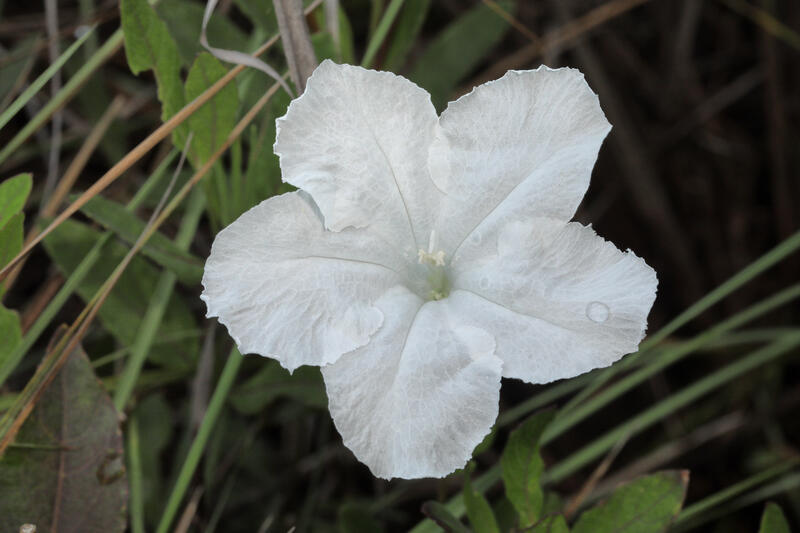







Loading profile. Please wait . . .
Ruellia noctiflora (Nees) Gray
Night-flowering Wild-petunia




Federal Protection: No US federal protection
State Protection: No Georgia state protection
Global Rank: G3?
State Rank: S1
Element Locations Tracked in Biotics: Yes
SWAP 2015 Species of Greatest Conservation Need (SGCN): Yes
SWAP 2025 Species of Greatest Conservation Need (SGCN): Yes
2025 SGCN Priority Tier: High Conservation Concern
Element Occurrences (EOs) in Georgia: 12
Habitat Summary for element in Georgia: Open, slash pine flatwoods
Perennial herb with slender, hairy, purplish stems 12 -16 inches (30 - 40 cm) tall. Leaves are 1 - 2.8 inches (3 - 7 cm) long, opposite, oval with pointed tips, and very short or no leaf stalks. Flowers are up to 4 inches (10 cm) across, glistening white, with 5 spreading petals; the tube and throat are more than 3 inches (8 - 10 cm) long; sepals are 0.5 - 1 inch (1.6 - 2.8 cm) long, very narrow, persisting around the base of the fruit as it develops. Flowers open at night then fall off by mid-morning. Fruit is an oval capsule, 0.8 inch (2 cm) long, with a long, persistent style.
No other plants in Georgia’s Coastal Plain flatwoods have large, white, petunia-like flowers and opposite leaves. Other Ruellia species have smaller, purple flowers. Some morning-glories have large, white flowers; these are all vines with alternate leaves.
Four species of Ruelllia are rare in Georgia:
Night-blooming Wild Petunia (Ruellia noctiflora, Special Concern) occurs moist to wet flatwoods and savannas, and low wet hammocks in southeast Georgia. For more information, see: https://www.georgiabiodiversity.org/portal/profile?group=plants&es_id=22444
Pineland Wild Petunia (Ruellia pinetorum, Special Concern) occurs in Dry to wet pine flatwoods and floodplains in the Coastal Plain. For more information, see: https://www.georgiabiodiversity.org/portal/profile?group=plants&es_id=21797
Pursh's Wild Petunia (Ruellia purshiana, Special Concern) occurs in dry woodlands and forests, especially over mafic or calcareous rocks, in north Georgia. For more information, see: https://explorer.natureserve.org/Taxon/ELEMENT_GLOBAL.2.147955/Ruellia_purshiana
Glade Wild Petunia (Ruellia strepens, Georgia Watch List) occurs in woodlands with calcium-rich soils and on limestone glades in Floyd and Catoosa Counties; its sepals are lance-shaped and about 0.1 inch (2 - 4 mm) wide. For photographs, see: https://www.discoverlife.org/mp/20q?search=Ruellia+strepens&flags=glean:&mobile=close
Moist to wet flatwoods and savannas, low wet hammocks.
Night-blooming Wild Petunia is a perennial herb that reproduces sexually b seed. Its flowers open in the evening then shrivel and drop off by the following morning; during the night, they are pollinated by hawkmoths whose long tongues probe the three-inch flower tubes for nectar produced by a ring of nectaries that encircle the base of the ovary.
Surveys are best conducted during flowering May–August.
Georgia, South Carolina, Florida, Alabama, Mississippi, and Louisiana,
Fire suppression, logging and other clearing, conversion of habitat to pine plantations and residential and commercial developments, ditching and draining wetlands, deer browsing.
| Threat 1 | Threat 2 | Threat 3 | |
|---|---|---|---|
| General Threat | Transportation & service corridors | Invasive & other problematic species, genes & diseases | Human intrusions & disturbance |
| Specific Threat | None | None | None |
Ruellia noctiflora is ranked S1 by the Georgia Department of Natural Resources, indicating that it is critically imperiled in the state. Eleven populations are currently known, about half on public and/or conservation lands.
Protect savannas, flatwoods, and prairies from conversion to pine plantations and developments. Burn pine flatwoods and seepage slopes every 2 - 3 years, preferably in the growing season. Avoid soil-disturbing activities such as bedding and plowing fire lanes. Avoid clearcutting floodplains and other forested wetlands. Reduce the size of Georgia’s deer herd.
Chafin, L.G. 2007. Field guide to the rare plants of Georgia. State Botanical Garden of Georgia and University of Georgia Press, Athens.
Fernald, M.L. 1945. Ruellia in the eastern United States. Rhodora 47: 1-90. https://www.jstor.org/stable/41764765?seq=1#metadata_info_tab_contents
Godfrey, R.K. and J.W. Wooten. 1981. Aquatic and wetland plants of southeastern United States, Vol. 2, dicotyledons. University of Georgia Press, Athens.
Long, R.W. 1970. The genera of Acanthaceae in the southeastern United States. Journal of the Arnold Arboretum 51 (3): 257-309. https://www.jstor.org/stable/43781693?seq=1#metadata_info_tab_contents
Long, R.W. 1971. Genetic and morphological relationships of the southeastern coastal plain endemic Ruellia noctiflora (Acanthaceae). Bulletin of the Torrey Botanical Club 98(1): 16-21. https://www.jstor.org/stable/2483492?seq=1#metadata_info_tab_contents
NatureServe. 2020. Species account for Ruellia noctiflora. NatureServe Explorer. NatureServe, Arlington, Virginia. https://explorer.natureserve.org/Taxon/ELEMENT_GLOBAL.2.141829/Ruellia_noctiflora
Sorrie, B.A. 1998. Noteworthy collections: Georgia. Castanea 63: 496-500. https://www.jstor.org/stable/4034002?seq=1#metadata_info_tab_contents
Wasshausen, D.C. 1998. Acanthaceae of the southeastern United States. Castanea 63(2): 99-116. https://www.jstor.org/stable/4034065?seq=1#metadata_info_tab_contents
Weakley, A.S. 2008. Flora of the Carolinas, Virginia, Georgia, northern Florida, and surrounding areas. University of North Carolina Herbarium, Chapel Hill. http://www.herbarium.unc.edu/flora.htm
Linda G. Chafin
L. Chafin, Aug. 2008: original account
K. Owers, Feb. 2010: added pictures
L. Chafin, May 2020: updated original account.